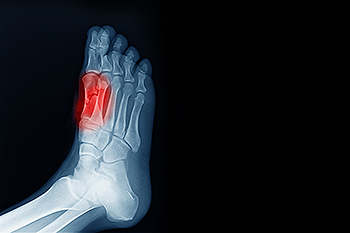Dallas Metro / North Texas
(214) 710-1028
Causes and Treatment of Sesamoiditis
Tuesday, 12 September 2023 00:00
Sesamoiditis is a condition that affects a pair of tiny bones called the sesamoids, found within the tendons beneath the base of the big toe. These bones act as natural shock absorbers, supporting the foot's weight-bearing function. When these bones become inflamed due to excessive pressure, overuse, or trauma, it results in sesamoiditis. The most common cause of sesamoiditis is repetitive stress on the foot, often associated with activities that can include dancing, running, or wearing high heels. Treatment for sesamoiditis typically involves rest and elevation to reduce inflammation. Wearing cushioned footwear and orthotics can alleviate pressure on the sesamoids. In severe cases, a podiatrist may recommend immobilization or corticosteroid injections. Surgery is rarely necessary but may be considered in extreme cases where conservative treatments are ineffective. Early diagnosis and intervention are essential to manage sesamoiditis and prevent chronic pain and complications. If you have developed sesamoiditis, it is strongly suggested that you visit a podiatrist who can effectively treat this condition.
Sesamoiditis is an unpleasant foot condition characterized by pain in the balls of the feet. If you think you’re struggling with sesamoiditis, contact Kellvan Cheng, DPM of Elite Foot & Ankle. Our doctor will treat your condition thoroughly and effectively.
Sesamoiditis
Sesamoiditis is a condition of the foot that affects the ball of the foot. It is more common in younger people than it is in older people. It can also occur with people who have begun a new exercise program, since their bodies are adjusting to the new physical regimen. Pain may also be caused by the inflammation of tendons surrounding the bones. It is important to seek treatment in its early stages because if you ignore the pain, this condition can lead to more serious problems such as severe irritation and bone fractures.
Causes of Sesamoiditis
- Sudden increase in activity
- Increase in physically strenuous movement without a proper warm up or build up
- Foot structure: those who have smaller, bonier feet or those with a high arch may be more susceptible
Treatment for sesamoiditis is non-invasive and simple. Doctors may recommend a strict rest period where the patient forgoes most physical activity. This will help give the patient time to heal their feet through limited activity. For serious cases, it is best to speak with your doctor to determine a treatment option that will help your specific needs.
If you have any questions please feel free to contact our office located in Carrollton, TX . We offer the newest diagnostic and treatment technologies for all your foot and ankle needs.




